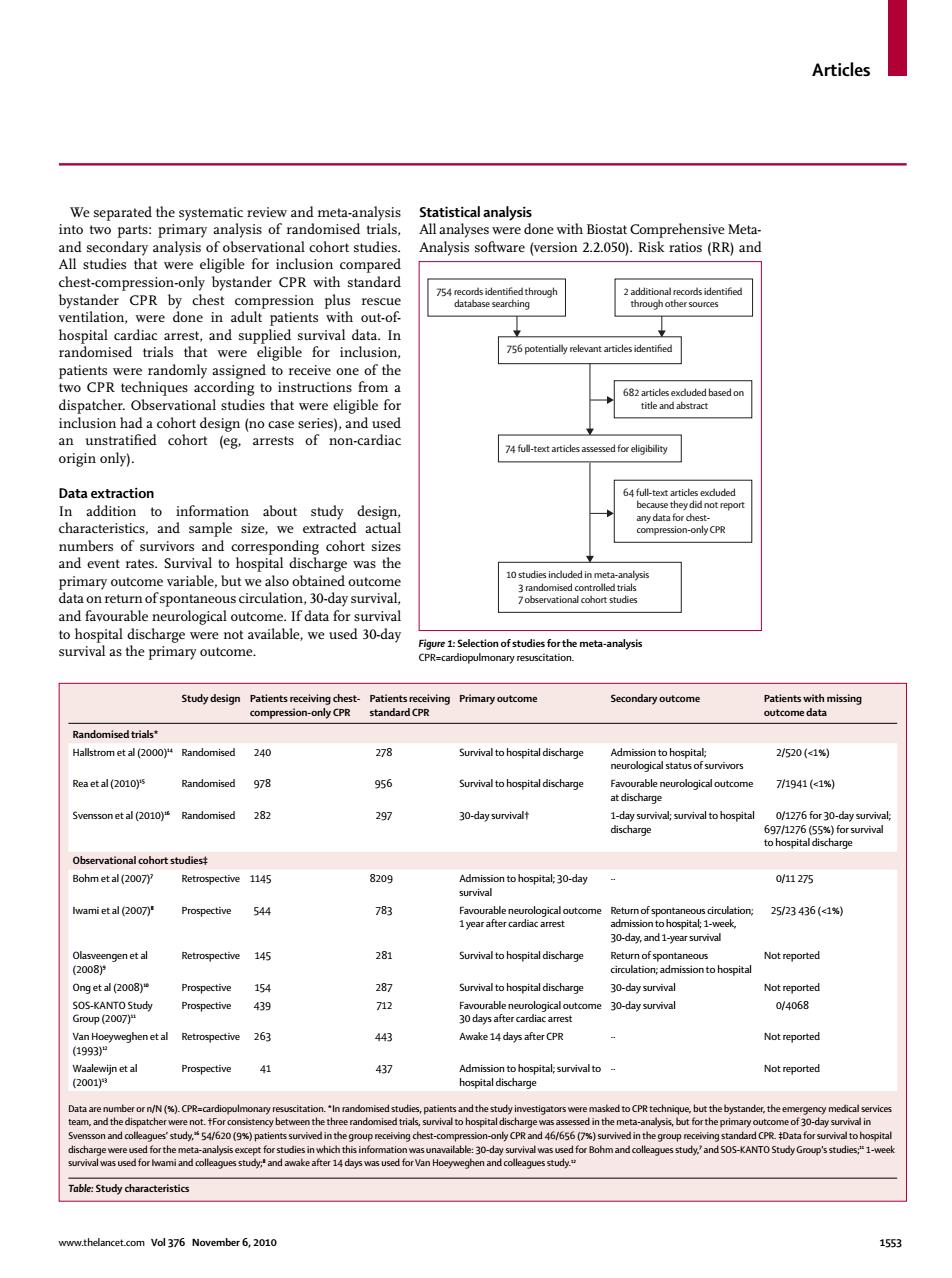正在加载图片...

Articles Analysis software (version 2.2.050).Risk ratios (RR)and chest-co ion-only bystander cpr with standard rom cnehomfedcohotgarstsofoaaida aogtigy and sample size,we and event rates.Survival to hospital dis ischarge was the 10 240 278 sraliohospitdixthagg Rea ctal2010 Randomised 978 6 7h941(e1影 nctal (2010y*Randomised 282 297 30-day survivalt 0/1276 for 30-day Bohm etal(2007 g09 tohosgitat30-doy 0/11275 (2007) 2523436(c1%) Retrospective 145 Survival to hospital discharge 15 28 urvival to hospital discharge 71 30-day surviva 4068 263 43 4 days after CP 1993 N( fan-day 54 used for Van Hoey 159Articles www.thelancet.com Vol 376 November 6, 2010 1553 We separated the systematic review and meta-analysis into two parts: primary analysis of randomised trials, and secondary analysis of observational cohort studies. All studies that were eligible for inclusion compared chest-compression-only bystander CPR with standard bystander CPR by chest compression plus rescue ventilation, were done in adult patients with out-ofhospital cardiac arrest, and supplied survival data. In randomised trials that were eligible for inclusion, patients were randomly assigned to receive one of the two CPR techniques according to instructions from a dispatcher. Observational studies that were eligible for inclusion had a cohort design (no case series), and used an unstratifi ed cohort (eg, arrests of non-cardiac origin only). Data extraction In addition to information about study design, characteristics, and sample size, we extracted actual numbers of survivors and corresponding cohort sizes and event rates. Survival to hospital discharge was the primary outcome variable, but we also obtained outcome data on return of spontaneous circulation, 30-day survival, and favourable neurological outcome. If data for survival to hospital discharge were not available, we used 30-day survival as the primary outcome. Statistical analysis All analyses were done with Biostat Comprehensive MetaAnalysis software (version 2.2.050). Risk ratios (RR) and Figure 1: Selection of studies for the meta-analysis CPR=cardiopulmonary resuscitation. 754 records identified through database searching 74 full-text articles assessed for eligibility 682 articles excluded based on title and abstract 756 potentially relevant articles identified 10 studies included in meta-analysis 3 randomised controlled trials 7 observational cohort studies 64 full-text articles excluded because they did not report any data for chestcompression-only CPR 2 additional records identified through other sources Study design Patients receiving chestcompression-only CPR Patients receiving standard CPR Primary outcome Secondary outcome Patients with missing outcome data Randomised trials* Hallstrom et al (2000)14 Randomised 240 278 Survival to hospital discharge Admission to hospital; neurological status of survivors 2/520 (<1%) Rea et al (2010)15 Randomised 978 956 Survival to hospital discharge Favourable neurological outcome at discharge 7/1941 (<1%) Svensson et al (2010)16 Randomised 282 297 30-day survival† 1-day survival; survival to hospital discharge 0/1276 for 30-day survival; 697/1276 (55%) for survival to hospital discharge Observational cohort studies‡ Bohm et al (2007)7 Retrospective 1145 8209 Admission to hospital; 30-day survival ·· 0/11 275 Iwami et al (2007)8 Prospective 544 783 Favourable neurological outcome 1 year after cardiac arrest Return of spontaneous circulation; admission to hospital; 1-week, 30-day, and 1-year survival 25/23 436 (<1%) Olasveengen et al (2008)9 Retrospective 145 281 Survival to hospital discharge Return of spontaneous circulation; admission to hospital Not reported Ong et al (2008)10 Prospective 154 287 Survival to hospital discharge 30-day survival Not reported SOS-KANTO Study Group (2007)11 Prospective 439 712 Favourable neurological outcome 30 days after cardiac arrest 30-day survival 0/4068 Van Hoeyweghen et al (1993)12 Retrospective 263 443 Awake 14 days after CPR ·· Not reported Waalewijn et al (2001)13 Prospective 41 437 Admission to hospital; survival to hospital discharge ·· Not reported Data are number or n/N (%). CPR=cardiopulmonary resuscitation. *In randomised studies, patients and the study investigators were masked to CPR technique, but the bystander, the emergency medical services team, and the dispatcher were not. †For consistency between the three randomised trials, survival to hospital discharge was assessed in the meta-analysis, but for the primary outcome of 30-day survival in Svensson and colleagues’ study,16 54/620 (9%) patients survived in the group receiving chest-compression-only CPR and 46/656 (7%) survived in the group receiving standard CPR. ‡Data for survival to hospital discharge were used for the meta-analysis except for studies in which this information was unavailable: 30-day survival was used for Bohm and colleagues study,7 and SOS-KANTO Study Group's studies;11 1-week survival was used for Iwami and colleagues study;8 and awake after 14 days was used for Van Hoeyweghen and colleagues study.12 Table: Study characteristics